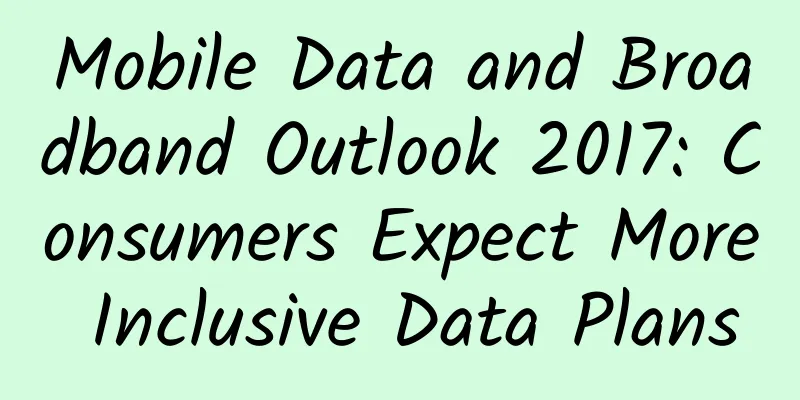Mobile Data and Broadband Outlook 2017: Consumers Expect More Inclusive Data Plans

|
According to foreign media reports, as an industry that never stops, the telecommunications industry has undergone many major changes in 2016, and it is certain that there will be even more changes in 2017.
Cellphone service plan charges could fall further, but recent trends suggest people should expect more inclusive data plans rather than big price cuts. I would like to see how mobile phone plan structures develop in overseas markets in the future, and for Australia, recent changes in the US market are very interesting. A key difference is the removal of all excess usage charges. Currently, major U.S. telecom companies throttle mobile data speeds when customers reach data caps, effectively eliminating data bill shock. This puts a cap on how much users can spend on mobile plans each month and gives telecom companies the opportunity to advertise their "unlimited data" plans -- even if only some of them reach full 4G speeds. For all this extra data, I hope telecom operators will bundle more content to help users use data more efficiently. This year, Optus bought the rights to broadcast English Premier League football and bundled it with customer plans, while Telstra and Vodafone already have close ties to the streaming music and video industries. It’s hard to guess the exact content partnerships, but it’s a safe bet that there will be more of them in the future. When it comes to the broadband market, all eyes are on the National Broadband Network. The number of homes and businesses connecting to the network continues to rise every month, meaning more households are now asking: "Should we connect to the National Broadband Network, and what speeds will it offer?" In fact, it's a big one. Despite the partisan bickering, the National Broadband Network is Australia's most important infrastructure project in decades - albeit one with a mission of its own. Early reports suggest that most households are waiting for the National Broadband Network, while those that do have broadband are opting for the slowest, cheapest plans. The National Broadband Network is expected to enhance its communications capabilities over the next year, offering all the benefits of a 100Mbps connection. 2017 will see greater advances in the future of the internet, virtual reality, remote health care and education, and higher-resolution video. The problem now is that it's hard to convince someone to pay now for a feature they might enjoy in the future. |
>>: Brocade Launches New Agile Data Center Portfolio to Help Enterprises Transform Digitally
Recommend
The number of active IPv6 users in my country has reached 608 million, and IPv6+ development has entered the second stage
On January 22, according to Feixiang.com, on Janu...
How to set up router bridging is actually very simple
A wireless router cannot fully cover the room. If...
Don’t say that 5G is just faster than 4G. Don’t you realize the importance of 5G?
Since the three major operators officially announ...
Wind River Wins Two Awards at 2017 SDN/NFV World Summit
At the 2017 SDN/NFV World Summit hosted by Layer1...
2021 China Internet Haha List 4: Top Ten Figures
2021 is a year of rapid change in the field of sc...
Aruba Expands Instant On Portfolio to Support Business Continuity and Rapid Capability Expansion for SMBs
Recently, Aruba, a subsidiary of Hewlett Packard ...
Huawei and China Southern Power Grid jointly released the "Smart Grid Next Generation Transport Technology Liquid OTN White Paper" to accelerate the digital transformation of the power industry
[Guangzhou, China, August 5, 2020] Huawei's &...
China's server virtualization market: Huawei ranks second in the market and ranks first in growth rate
Nowadays, in such a competitive market as server ...
Yahoo's valuation dropped from $4.8 billion to $350 million, 32 million accounts leaked due to "cookie forgery"
[51CTO.com original article] Yahoo's latest n...
Telecommunication Research Institute report shows that 5G indoor coverage is only 60%
In the third and fourth quarters of 2021, China T...
The latest global ranking of 5G standard essential patents: Huawei first, Samsung second
Recently, IPLytics, an internationally renowned p...
How high is the spectrum efficiency of 5G?
Wireless spectrum is the most valuable resource f...
I have no resistance to these 6 excellent computer software
[[389531]] Excellent computer software can greatl...
MIIT talks about 6G: Breakthroughs in key core technologies are needed
According to the news from the Ministry of Indust...
Four tips for smart building integrated wiring that you don’t know!
Smart buildings are gradually showing the intelli...




![[2024] What are the VPS in Hong Kong? How to choose a VPS in Hong Kong? Check out the information of VPS merchants in Hong Kong](/upload/images/67cabc6909af9.webp)




